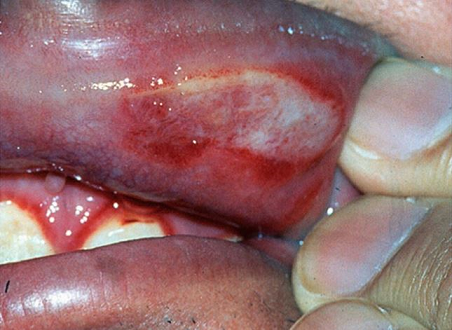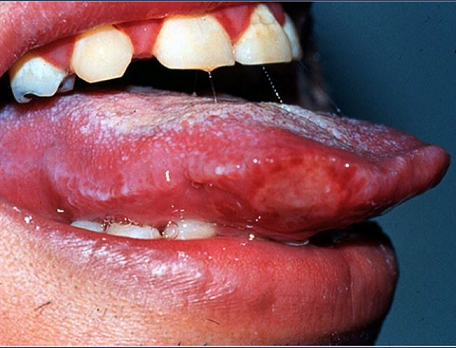|
|
|
Medical Pharmacology Chapter 36: Antiviral Drugs
Antiviral Drugs
Anti-viral drugs with activity against HIV (Human Immunodeficiency Virus)
HIV-1 Pathophysiology/Pathogenesis: HIV Disease Presentations
Frequently observed presentations of HIV infection include both oropharyngeal gastrointestinal diseases.2
These presentations are most typically observed as a result of secondary infections as a result of HIV-induced immunodeficiency.
![]() Oral lesions,
frequently seen in untreated HIV infection include thrush,
leukoplakia
and aphthous ulcers.2
Oral lesions,
frequently seen in untreated HIV infection include thrush,
leukoplakia
and aphthous ulcers.2
 |
|
![]() Thrush
as a result of Candida infection is suggestive of
relatively advanced immunologic compromise.
Thrush
as a result of Candida infection is suggestive of
relatively advanced immunologic compromise.
Oral hairy leukoplakia, probably due to Epstein-Barr virus (EBV), is also indicative of relatively advanced immunologic compromise.
These diseases are most likely seen in patients with CD4+ T cell counts of <300/ÁL.2
The white appearance in oral hairy leukoplakia is due to hyperkeratosis and epithelial hyperplasia.9
Following initial resolution of a primary Epstein-Barr viral infection, viral persistence remains due to latent B lymphocyte infection.10
Epstein-Barr virus causes oropharyngeal lytic infections which are not controlled in immunocompromised individuals and manifest as oral hairy leukoplakia.
Oral hairy leukoplakia may be noted in individuals receiving transplants and are accordingly on immunosuppressive drugs; however, typically the immunocompromise is secondary to immunological suppression due to HIV/AIDS.9
|
|
|
|
|
|
Aphthous ulcers sometimes also referred to as aphthous stomatitis may be seen in patients with HIV infection.2
One prominent site for aphthous ulcers is the posterior oropharynx.2
However, other locations such as tongue and lips are common.12
HIV patients not receiving contemporary anti-retroviral agents are at a higher risk.12
Furthermore, these lesions may be painful, interfering with swallowing.2,11
Symptoms may exhibit "prodromal" sensations including burning or itching prior to lesion appearance.11
Pain associated with these ulcers is worst just following initial ulcer formation.11
 |
 |
|
|
Esophagitis presents as retrosternal pain along with difficulty in swallowing (odynophagia).2
Definitive diagnosis usually depends on upper endoscopy.
Several causes are responsible for esophagitis including:
Candida
Cytomegaloviral infection (CMV)
Herpes simplex viral infection (HSV).
|
|
|
If a single large ulcers found, the cause is probably CMV.
By contrast, multiple small ulcers suggest herpes simplex virus as causative.2
The most common esophageal infection in HIV-infected patients is due to Candida (Candidal esophagitis).14
|
|
|
A combination of dysphasia along with oral thrush predicts at a level of 90% esophageal candidiasis.14
At CD4+ T cell counts <50/ÁL CMV as well as idiopathic esophageal ulcerations may be more likely found.
In this setting, significant pain on swallowing is typically the first symptom.
Endoscopy often reveals large ulcerations with elevated margins; CMV inclusions are noted in biopsy analysis.
Esophagitis due to herpes simplex virus infections (CMV) are much less likely to occur and are associated with relatively shallow esophageal ulcerations. Idiopathic disease is diagnosed by the absence of viral evidence upon biopsy.14
|
|
This Web-based pharmacology and disease-based integrated teaching site is based on reference materials, that are believed reliable and consistent with standards accepted at the time of development. Possibility of human error and on-going research and development in medical sciences do not allow assurance that the information contained herein is in every respect accurate or complete. Users should confirm the information contained herein with other sources. This site should only be considered as a teaching aid for undergraduate and graduate biomedical education and is intended only as a teaching site. Information contained here should not be used for patient management and should not be used as a substitute for consultation with practicing medical professionals. Users of this website should check the product information sheet included in the package of any drug they plan to administer to be certain that the information contained in this site is accurate and that changes have not been made in the recommended dose or in the contraindications for administration. Advertisements that appear on this site are not reviewed for content accuracy and it is the responsibility of users of this website to make individual assessments concerning this information. Medical or other information thus obtained should not be used as a substitute for consultation with practicing medical or scientific or other professionals. |